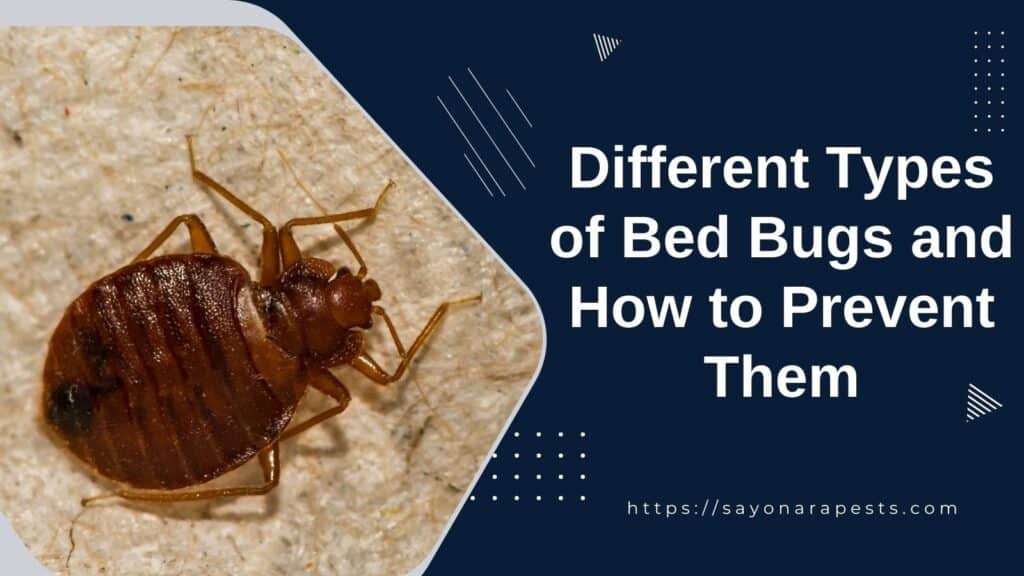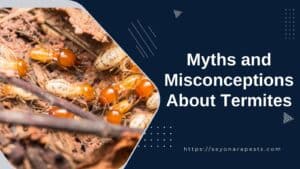Infestations of bed bugs have become a major problem for homeowners, hotels, and businesses all over the world in recent years. These tiny insects that feed on blood can cause pain, trouble sleeping, and even health problems.
Understanding the different kinds of bed bugs is important for preventing them and getting rid of them.
The most well-known species of bed bug is the common bed bug (Cimex lectularius), but there are other types, like the tropical bed bug (Cimex hemipterus) and bat bugs (Cimex adjunctus and Cimex pilosellus), that can also live in human homes.
Each species has its own traits, habits, and geographic range, so it’s important to know a lot about the different kinds in order to fight infestations effectively.
The growing worry about bed bug infestations around the world makes it important to talk about the different kinds of bed bugs and how to avoid them. Bed bugs are not just annoying; they can also affect a person’s physical and mental health.
Infestations can cause allergic reactions, rashes, anxiety, and trouble sleeping. Also, bed bugs have a big effect on the economy because they cost a lot to get rid of, cause businesses to lose money and damage property.
By learning about the different kinds of bed bugs and how to avoid them, people can get the information they need to find, prevent, and get rid of bed bug infestations.
This is important information for homeowners, people who work in the hospitality industry, and anyone else who wants to keep these pests out of their homes and places where they sleep.
What are Bed Bugs?
Bed bugs are small bugs in the family Cimicidae that don’t have wings. They are ectoparasites, which means that they feed on the blood of humans and other animals with warm blood, mostly at night.
When fully grown, these pests have flat, oval bodies about the size of an apple seed. Their bodies are usually a reddish-brown color, but it depends on what they eat on how dark or light they look.
One of the most important things about bed bugs is that they can hide in small cracks and tight spaces, which makes them hard to find and get rid of. They are good at hitchhiking and can easily attach themselves to bags, clothes, and furniture.
This lets them move quickly from one place to another. Bed bugs are mostly active at night and are drawn to the carbon dioxide and heat that humans give off when they sleep. This helps them find their hosts.
Bed bugs have been a problem for people for hundreds of years. They were once thought to be gone from developed countries, but their return in the last few decades has been worrying.
Bed bugs have been around for a very long time. Fossilized remains and old writings show that they were around back then.
At the beginning of the 20th century, the use of powerful insecticides like DDT led to a big drop in the number of bed bugs. But the ban on DDT and the fact that bed bugs have become resistant to insecticides have helped them come back.
Some of the things that have led to their comeback are more international travel, the rise of shared living spaces, and a lack of public awareness.
Bed bugs are a problem all over the world today. They can be found in homes, hotels, dorms, hospitals, and other public places.
Once an infestation starts, it’s hard to get rid of them because they can reproduce quickly and are resistant to many common insecticides.
To prevent and get rid of bed bugs effectively, you need to know about their history and what they look like.
People and communities can protect themselves from the discomfort and possible health risks that come with bed bugs by staying informed and taking preventative measures.
Different Types of Bed Bugs
Common Bed Bug (Cimex Lectularius)
The scientific name for the common bed bug is Cimex lectularius. It is a small, rusty-brown insect that is about 5–7 millimeters long. Its body is flat and oval, and its mouth part called a proboscis, looks like a beak.
The adults are a rusty brown color, while the young ones, called nymphs, look clear or light yellow. They don’t have wings, but they use their six legs to crawl and move around on different surfaces.
Bed bugs usually come out at night and are attracted to the heat and carbon dioxide that people give off. They live in many places inside, especially beds, mattresses, and upholstered furniture, where people sleep.
But they can also be found in wall cracks and crevices, behind electrical outlets, in luggage, and on people.
Bed bugs are hardy pests that can go for a few months without eating. They are good at hiding in small spaces, which makes them hard to find and get rid of.
When they find a possible host, they come out from where they are hiding and feed on the person’s blood for about five to ten minutes before going back to where they were hiding.
Bed bugs that are common are found all over the world, in both homes and businesses. They are common in places where there are a lot of people, such as cities, hotels, dorms, and hospitals.
Their presence is not limited to a certain area or climate, but they are usually found in places where people travel and move around a lot.
Tropical Bed Bug (Cimex Hemipterus)
The tropical bed bug, which is called Cimex hemipterus by scientists, looks a lot like the common bed bug.
They are both small, reddish-brown, and have flat bodies. But the tropical bed bugs are about 7-8 millimeters long, which makes them a bit bigger.
Bed bugs get their name from the fact that they are mostly found in warmer climates and tropical areas.
Compared to common bed bugs, they like warmer and more humid conditions. Just like the common bed bug, they live in places like homes, hotels, and hospitals. They also like to live in wall cracks and crevices, furniture, and bedding.
The way tropical bed bugs feed and hide is the same as the way their common counterparts do. They come out at night and drink the blood of the people they live with.
They can go for long periods without eating, just like other bed bugs.
Tropical bed bugs can be found all over the world in tropical and subtropical areas. They are most common in countries with warmer weather, like Southeast Asia, Africa, and the Caribbean.
But because of more travel and globalization, tropical bed bugs have been found in places where they are not normally found. This shows how important it is to be aware of the problem and take steps to stop it.
Bat bugs (Cimex Adjunctus and Cimex Pilosellus)
Bat bugs and bed bugs are related and come from the same genus, Cimex. Bat bugs come in two main types: Cimex adjunctus and Cimex pilosellus.
They look a lot like bed bugs and have a lot of the same physical traits. But there are some small differences between the two groups that help experts tell them apart.
Bat bugs are about 6–9 millimeters long, which is a little bit longer than most bed bugs.
As their name suggests, bat bugs are very close to bats and mostly live in bat colonies. They often live in attics, walls, and other places near where bats live.
When bats move or leave their roosts, the bugs that live on them may look for other hosts, like humans. This could lead to bat bug infestations in homes and buildings.
In terms of how they act, bat bugs are a lot like bed bugs. They come out at night and feed on the blood of their hosts, which can be bats or sometimes people.
But bat bugs have changed over time to be able to live in bat habitats, so they may act and like different things than bed bugs.
Bat bugs are very close to bats because they depend on bat colonies to stay alive. They have special features that help them find their way around and live well in bat environments.
The number of bat bugs can go up or down depending on the size and activity of the bat colonies they live in. When bats leave or stop using a roost, bat bugs may spread out and look for other hosts, such as humans, which could lead to infestations in homes.
Signs and Symptoms of Bed Bug Infestations
Identifying Bites and Skin Reactions
People who have been bitten by bed bugs or whose skin has reacted to them are one of the best ways to tell if there is an infestation. Bed bug bites usually look like mosquito bites: they are small, red, and itchy.
But, unlike mosquito bites, which tend to show up one at a time, bed bug bites tend to show up in groups or straight lines on parts of the body that are exposed, like the arms, legs, neck, or face.
These bites may not show up for a few days and can hurt in different ways depending on how sensitive you are.
Even though bed bugs aren’t known to spread diseases, they can cause secondary infections if their bites are scratched too much. So, it’s important to find and get rid of bed bug problems as soon as possible.
Visual Signs of Bed Bugs
In addition to bites, visual signs of bed bugs can be a strong proof of an infestation. Bed bugs are small, flat, oval-shaped bugs that are usually between 4 and 5 millimeters long.
Adult bed bugs are a reddish-brown color, but young bed bugs, called nymphs, are clear or light yellow. If you look at the seams of the mattress, the bed frame, the headboard, and any nearby furniture, you might find bed bugs or their waste.
Look for dark spots or smudges on your bedding, walls, or furniture. These are often made of bed bug poop. Exoskeletons of dead bed bugs or a sweet, musty smell in the area can also be signs of an infestation.
Detecting Bed Bug Eggs and Nymphs
To know for sure if there are bed bugs in your home, you need to find their eggs and young. The eggs of bed bugs are about 1 millimeter long and pearly white. They are usually laid in groups, usually in cracks and crevices close to where they live.
Some of these places are the seams of mattresses, the joints of furniture, and even behind wallpaper. On the other hand, nymphs look like smaller versions of adult bed bugs, but they don’t have fully grown wings.
They go through several molts before they reach adulthood, and their old exoskeletons can be found in places where they are still a problem.
When looking for eggs and nymphs, you need to look carefully and thoroughly because they are so small that they are easy to miss.
Understanding the Life Cycle of Bed Bugs
Understanding the life cycle of bed bugs is important for finding infestations and coming up with good ways to get rid of them. Bed bugs slowly change into adults.
They go through five stages of nymphal development before they become adults. For each nymphal stage to grow and change, it needs to eat blood.
From egg to adult, the whole process can take between 4 and 7 weeks, depending on things like temperature and the availability of hosts. Adult bed bugs can go for a few months without eating, which makes them strong and hard to get rid of.
This long life cycle and ability to adapt show how important it is to use comprehensive treatment plans to get rid of infestations for good.
If you want to deal with a bed bug problem effectively, you need to be able to recognize the signs and symptoms of an infestation.
By recognizing the bites and skin reactions caused by bed bugs, people can act quickly to stop the spread of the problem and make themselves feel better.
Bed bugs that are still alive, feces spots, or exoskeletons are all visible signs that there is an infestation.
Bed bug eggs and nymphs are often hidden in cracks and crevices, so it takes a careful look and attention to detail to find them.
Lastly, knowing the life cycle of bed bugs makes it possible to control and get rid of them in a complete way.
By being aware of these signs and symptoms, people can take steps to protect themselves from bed bug infestations and get professional help when they need it.
Prevention and Control Methods
Maintaining cleanliness and hygiene
Keeping living spaces clean and tidy is one of the most important ways to stop bed bugs from taking over. Bed bugs are attracted to dirty and messy places, so it’s important to clean and declutter your home often.
The best way to get rid of bed bugs or their eggs is to vacuum and sweep the floors, especially in bedrooms and other places where people sleep. Bed bugs and their eggs can also be killed by washing sheets, curtains, and clothes in hot water.
You can make it much less likely that bed bugs will take over your home by keeping it clean and free of clutter.
Regular inspection of sleeping areas
Another important preventive step is to check your sleeping area often. Since bed bugs are mostly active at night and hide during the day, it can be hard to find them.
But if you do regular inspections, you can spot early signs of an infestation and take action right away. Use a flashlight to look for hiding places in the seams of the mattress, the bed frames, the headboards, and other places.
Look for bugs that are still alive, dark spots (which are bed bug poop), shed skin, or tiny white eggs. During your inspections, if you see any signs of bed bugs, you need to get rid of them right away.
Effective use of mattress encasements
Putting a mattress cover on your mattress is a practical and proactive way to keep bed bugs from getting into your bed. A mattress encasement is a cover that goes all the way around the mattress and protects it from bed bugs.
Make sure the case is made to keep bed bugs out, with a tight zipper and seams that are reinforced. By putting a cover on your mattress, you create a physical barrier that stops bed bugs from getting in or out.
This makes it easier to find and get rid of a bed bug problem. Don’t forget to check the case often for signs of bed bugs or damage.
Travel precautions and awareness
Bed bugs are known to hitchhike, and they can easily get into your luggage and other things you bring with you when you travel. When you travel, it’s important to take the right steps to make sure you don’t bring bed bugs back home with you.
Before you get comfortable in a hotel room, check the sheets, seams of the mattress, and furniture for signs of bed bugs. Use a luggage rack or keep your suitcase off the floor to make it less likely that bed bugs will crawl into your things.
Wash and dry your travel clothes on high heat when you get back home to get rid of any hitchhikers.
Professional pest control measures
If there are a lot of bed bugs, it’s best to call a professional pest control service. Pest control experts know how to get rid of bed bugs because they have the knowledge, experience, and special tools to do so.
They can do thorough inspections, figure out how bad the problem is, and use the right treatment methods. Bed bugs can be gotten rid of from your home by hiring a professional exterminator.
They may use a combination of methods, such as heat treatments, insecticides, and steam cleaning. For the best results, it’s important to hire a reputable pest control company that knows how to get rid of bed bugs.
Education and awareness of public places
Bed bugs can be prevented and controlled by making people aware of them and teaching them about them. Bed bugs are more likely to spread in public places like hotels, dorms, and housing complexes with many units.
To reduce the risk of infestation, businesses should do regular inspections and take preventive steps. It is also important to teach staff and residents about the signs of bed bugs, the right way to report them, and how to avoid them.
Bed bugs can be kept from spreading by raising awareness and taking preventative steps. This makes places safer for everyone.
There are many things that need to be done to stop and get rid of bed bug infestations.
Maintaining cleanliness and hygiene, regularly inspecting sleeping areas, using mattress encasements, taking precautions when traveling, getting professional pest control services when needed, and spreading education and awareness in public places are all important steps.
By taking these precautions and being on the lookout, you can greatly reduce the chance of bed bug infestations and keep these annoying bugs out of your home.
When you’re trying to get rid of bed bugs, it’s very important to know what kind you’re dealing with. Bed bugs are now a worldwide problem that can be found in homes, hotels, and other public places.
By learning about the different species, like the common bed bug (Cimex lectularius), the tropical bed bug (Cimex hemipterus), and the bat bugs (Cimex adjunctus and Cimex pilosellus), we can learn a lot about how they act, where they live, and where they live.
Each kind of bed bug has different habits and traits that affect how to control and get rid of them.
For example, knowing that common bed bugs are most often found in temperate areas and that tropical bed bugs do best in warmer climates can help preventative measures be more effective.
By figuring out the type of bed bug infestation, homeowners and pest control experts can take more effective steps to treat and prevent the problem.
To stop and get rid of bed bug infestations, you need a multifaceted plan that includes both preventative steps and quick actions. Keeping living spaces clean and tidy is important because it makes it less likely that bed bugs will find the right conditions to grow.
When sleeping areas, like mattresses, box springs, and furniture, are checked regularly, problems can be found and fixed quickly.
Using mattress encasements is a good idea if you want to add an extra layer of protection. These covers keep bed bugs from getting into the mattress and make it easier to find and get rid of them.
It is important to take precautions when traveling, like checking hotel rooms and luggage, so that you don’t bring bed bugs back home.
Even though you can get rid of small pest problems on your own, it’s usually best to call a professional if the problem is big or keeps coming back.
Pest control professionals have more effective ways to get rid of bed bugs because they know more about them, have more experience, and have access to more specialized treatments.
They can also give you advice on long-term ways to stay safe that are suited to your situation.
Having to deal with bed bugs can be hard and stressful. Even when people try their best, the infestation may stay or even get worse.
At this point, it’s important to get help from a professional. Pest control experts have the knowledge and tools to deal with bed bug infestations effectively.
They use advanced techniques and treatments that most people don’t have access to.
Professional help has many benefits, such as thorough inspections to find out how bad the problem is, treatments that are tailored to the type of bed bug, and thorough follow-up to make sure the problem is gone for good.
Professionals in pest control can also give you good advice on how to keep bed bugs from coming back. This will give you peace of mind and help you create a bed-bug-free environment.
When it comes to getting rid of bed bugs, it’s important to act quickly. If you think you have an infestation or can prove it, don’t wait to call a reputable pest control company.
Their knowledge and help can make a big difference in how quickly and effectively the problem is fixed, giving you control over your living space and protecting your health.










